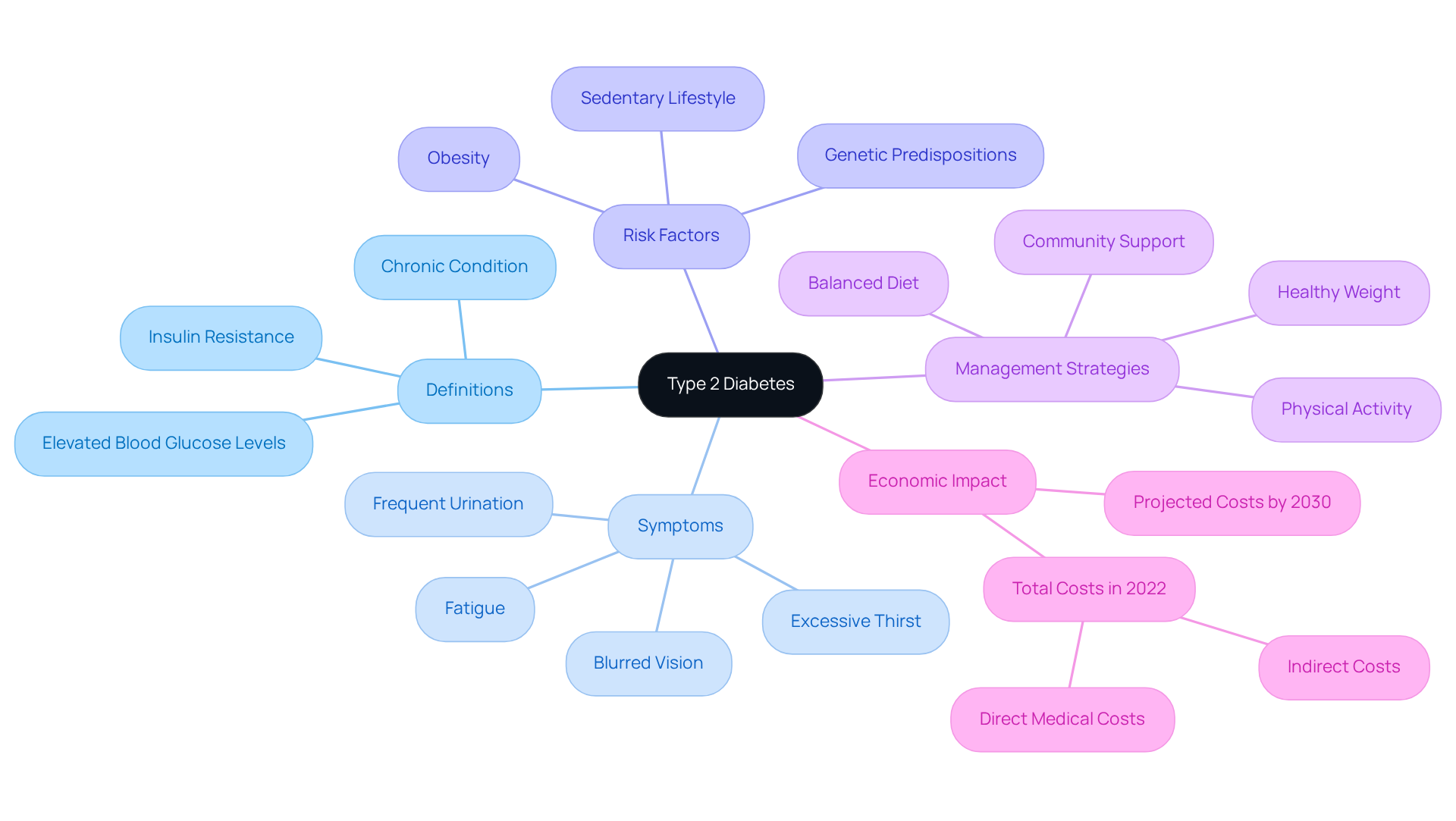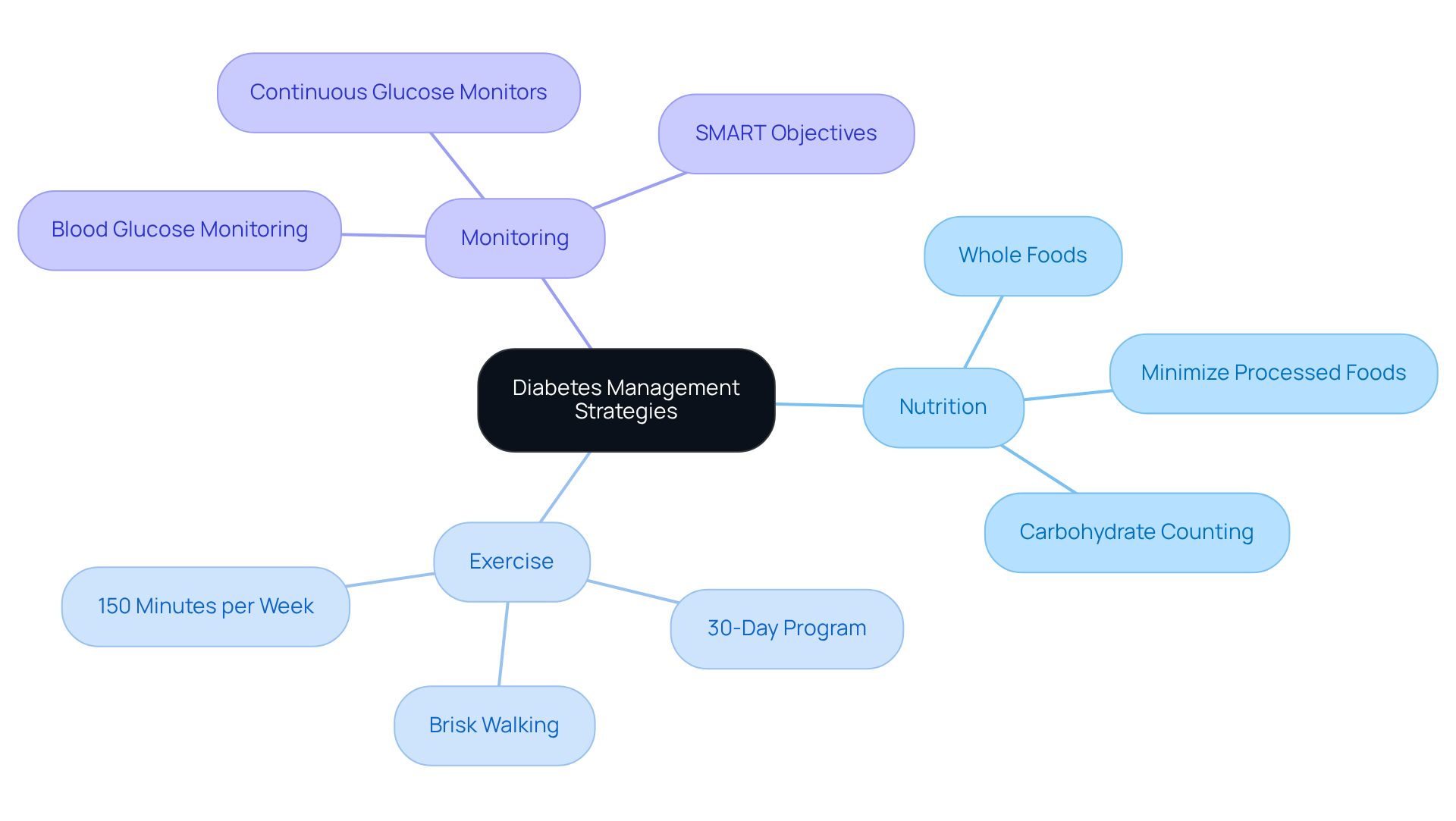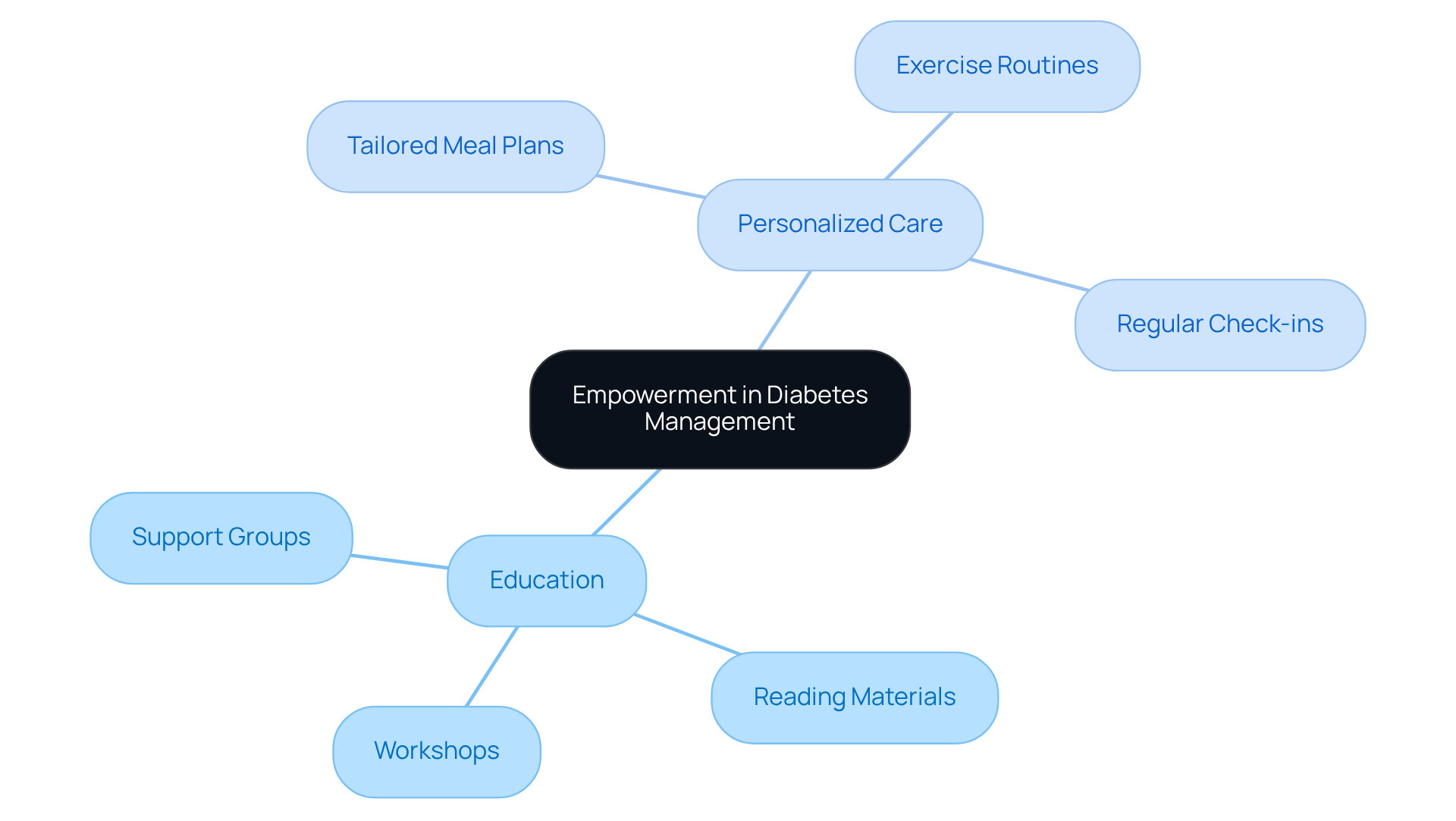Overview
Managing Type 2 diabetes can often feel overwhelming, but there are effective strategies that can help you regain control. A comprehensive approach that emphasizes nutrition, regular physical activity, and continuous monitoring of blood glucose levels is essential. Many patients find that adopting balanced diets and structured exercise plans not only empowers them to manage their condition but also improves their overall health outcomes. It’s important to recognize that personalized care plays a vital role in this journey, offering the support needed to navigate the challenges ahead. By focusing on these key areas, you can take meaningful steps toward a healthier lifestyle.
Introduction
Type 2 diabetes presents significant challenges, impacting millions through its intricate relationship with insulin resistance and elevated blood sugar levels. It’s important to recognize that managing this chronic condition goes beyond treatment; it requires a holistic approach that embraces lifestyle changes, nutritional strategies, and continuous monitoring. Many patients find that navigating the often-overwhelming landscape of diabetes management can be daunting.
How can individuals regain control over their health and achieve optimal outcomes? This article explores essential strategies and insights designed to empower patients on their diabetes journey, fostering a healthier and more fulfilling future.
Understand Type 2 Diabetes: Key Concepts and Definitions
Type 2 diabetes is a chronic condition that can feel overwhelming, marked by insulin resistance and elevated blood glucose levels due to the body’s ineffective use of insulin. This can lead to higher sugar levels in the bloodstream, which, if not managed, may result in serious health complications. Common symptoms like excessive thirst, frequent urination, fatigue, and blurred vision are important to recognize. Understanding these signs is crucial for early detection and timely intervention, significantly improving health outcomes.
It’s important to recognize that this condition is often linked to obesity, a sedentary lifestyle, and genetic predispositions. Recent research highlights that insulin resistance, where cells struggle to respond to insulin, plays a pivotal role in developing type 2 diabetes. Many patients find that this resistance can lead to progressively higher blood sugar levels, making a comprehensive management approach essential.
By understanding these risk factors, individuals can take proactive steps to manage their health. For instance, lifestyle adjustments like maintaining a healthy weight, engaging in regular physical activity, and adopting a balanced diet can greatly reduce the risk of developing this condition. In San Marcos, CA, embracing the outdoor lifestyle by utilizing local parks and trails for exercise is vital for improving insulin sensitivity and controlling weight. Additionally, incorporating fresh, local produce from vibrant farmers’ markets into meals can support a diabetes-friendly diet rich in fiber and nutrients.
Moreover, early diagnosis through simple blood tests can facilitate timely interventions, potentially preventing disease progression and its associated complications. Community wellness programs in San Marcos offer invaluable support, providing resources tailored to effectively manage blood sugar levels. These programs often include personalized advice, group support, and opportunities for stress management through activities like yoga and meditation.
In 2022, the total expense of health issues related to blood sugar regulation in the U.S. was $412.9 billion, highlighting the economic strain of this condition. Dr. Jason Shumard emphasizes that his approach not only targets the symptoms but also seeks to uncover and treat the underlying causes of these chronic conditions. His center offers an extensive 30-Day Diabetes Reset program aimed at equipping patients with essential tools and understanding to improve their well-being and manage their condition effectively. By addressing societal and cultural challenges in preventing this condition, individuals can better navigate their health journeys and make informed choices.
Implement Effective Management Strategies: Nutrition, Exercise, and Monitoring
Managing a type 2 condition, specifically in terms of diabetes management type 2, can feel overwhelming at times, but a comprehensive strategy can make a significant difference. This approach to diabetes management type 2 includes nutrition, physical activity, and regular monitoring, all designed to support your journey toward better health.
-
Nutrition: A balanced diet is crucial. Consider focusing on whole foods like vegetables, lean proteins, and whole grains. In diabetes management type 2, it’s helpful to minimize processed foods and added sugars, as these can lead to spikes in blood sugar levels. Have you tried carbohydrate counting? It’s a practical strategy for diabetes management type 2 that can assist you in maintaining better control over your glucose levels.
-
Exercise: Engaging in consistent physical activity is essential for improving glucose sensitivity and aiding weight control. Current guidelines suggest at least 150 minutes of moderate-intensity exercise each week. Activities like brisk walking, cycling, or strength training can be enjoyable ways to stay active. Many patients find success with structured programs, such as Dr. Shumard’s comprehensive 30-Day program for diabetes management type 2, which includes tailored exercise plans that have shown tangible benefits in improving insulin sensitivity.
Regular blood glucose monitoring is vital for diabetes management type 2. It helps you understand how your diet, exercise, and medications affect your blood sugar levels. Continuous glucose monitors (CGMs) provide real-time data, empowering you to make informed decisions about your management strategies. This proactive approach not only helps with immediate adjustments but also contributes to long-term health improvements in diabetes management type 2. Have you considered using fitness apps or journals? They can enhance accountability and motivation. Establishing SMART objectives—specific, measurable, attainable, relevant, and time-bound—can significantly enhance your focus and motivation in managing your health.
Common pitfalls in diabetes management type 2 highlight the frequent mistakes many patients encounter, such as neglecting regular monitoring or failing to adjust dietary choices based on blood sugar readings. By acknowledging these challenges, you can better navigate your health journey and make informed decisions. Remember, you’re not alone in this, and seeking support can lead to positive changes.
Adopt a Holistic Approach: Empowerment Through Education and Personalized Care
A comprehensive strategy for handling diabetes centers on empowering patients through education and personalized care—essential components for effective management of the condition. Providing materials that enhance understanding of the disease and the influence of lifestyle choices is crucial in developing self-management skills.
Education: Have you considered how engaging in workshops, reading educational materials, or joining support groups might improve your self-management abilities? Increasing awareness about diabetes not only enriches understanding but also equips individuals with the resources necessary for effective health oversight.
Personalized Care: It’s important to recognize that each person’s journey with diabetes is unique. Customizing strategies to align with individual preferences, lifestyles, and wellness goals is vital. This may include tailored meal plans, exercise routines, and regular check-ins with healthcare providers to ensure that treatment adjustments are made as needed. Many patients find that personalized management strategies for blood sugar control lead to better adherence and improved clinical outcomes, including significant reductions in HbA1c levels.
By fostering a supportive and educational environment, patients can feel a greater sense of control over their health, leading to improved quality of life and reduced reliance on traditional medical interventions. This empowerment is further strengthened by integrating educational resources, such as seminars and literature, which offer valuable insights into effectively managing diabetes.
Conclusion
Managing type 2 diabetes can feel overwhelming, but it’s important to recognize that you are not alone in this journey. Understanding your condition is the first step toward better health outcomes. By identifying the symptoms, risk factors, and underlying causes of type 2 diabetes, you can take proactive steps that can truly make a difference in your life. This knowledge empowers you to make informed decisions about lifestyle changes, medical interventions, and overall health management.
Essential strategies can help you navigate this path. Maintaining a balanced diet, engaging in regular physical activity, and monitoring your blood glucose levels are vital. Many patients find that adopting these habits not only improves insulin sensitivity but also helps in controlling blood sugar levels. Moreover, education and personalized care play a crucial role; tailored approaches can empower you to take charge of your health and effectively manage your diabetes journey.
The significance of a comprehensive management strategy cannot be overstated. By embracing education, personalized care, and community support, you can enhance your quality of life while also reducing the economic burden associated with diabetes. Remember, prioritizing your health through informed choices and proactive management is key. Together, we can ensure a brighter future for everyone living with type 2 diabetes. Take that first step today—your journey toward a healthier life starts now.
Frequently Asked Questions
What is type 2 diabetes?
Type 2 diabetes is a chronic condition characterized by insulin resistance and elevated blood glucose levels due to the body’s ineffective use of insulin, which can lead to serious health complications.
What are the common symptoms of type 2 diabetes?
Common symptoms include excessive thirst, frequent urination, fatigue, and blurred vision. Recognizing these signs is crucial for early detection and timely intervention.
What factors contribute to the development of type 2 diabetes?
Type 2 diabetes is often linked to obesity, a sedentary lifestyle, and genetic predispositions. Insulin resistance plays a pivotal role in its development.
How can individuals reduce their risk of developing type 2 diabetes?
Individuals can reduce their risk by maintaining a healthy weight, engaging in regular physical activity, and adopting a balanced diet rich in fiber and nutrients.
What lifestyle changes are recommended for managing type 2 diabetes?
Recommended lifestyle changes include utilizing local parks and trails for exercise and incorporating fresh produce from farmers’ markets into meals to support a diabetes-friendly diet.
How is type 2 diabetes diagnosed?
Early diagnosis can be facilitated through simple blood tests, which allow for timely interventions that may prevent disease progression and complications.
What resources are available for managing type 2 diabetes in San Marcos, CA?
Community wellness programs in San Marcos provide resources tailored to managing blood sugar levels, including personalized advice, group support, and stress management activities like yoga and meditation.
What is the economic impact of type 2 diabetes in the U.S.?
In 2022, the total expense of health issues related to blood sugar regulation in the U.S. was $412.9 billion, highlighting the economic strain of this condition.
What is the 30-Day Diabetes Reset program?
The 30-Day Diabetes Reset program is offered by Dr. Jason Shumard’s center and aims to equip patients with essential tools and understanding to improve their well-being and manage their condition effectively.
How does Dr. Jason Shumard approach treatment for type 2 diabetes?
Dr. Shumard’s approach targets not only the symptoms of type 2 diabetes but also seeks to uncover and treat the underlying causes of chronic conditions.


